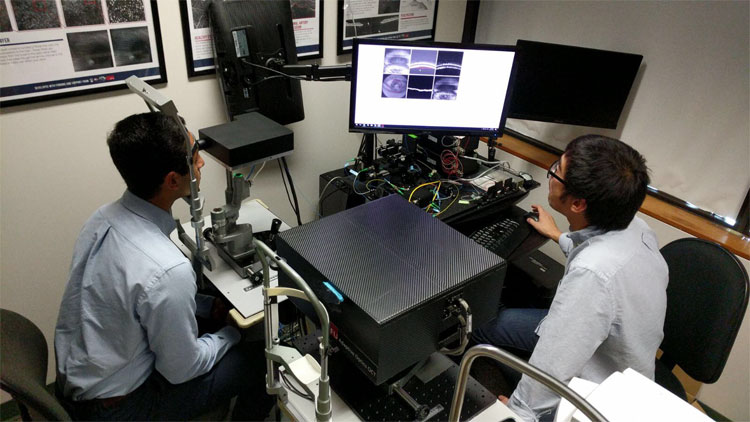Laser Scanner Could Help Diagnose Disease Before Vision Loss Occurs
source:Photonics
release:Nick
keywords: Laser Scanner Medical laser applications
Time:2017-12-29
BURNABY, British Columbia, Dec. 28, 2017 — A retinal imaging scanner has been developed that can produce high-resolution, 3D cross-sectional images of the retina, including individual photoreceptors and fine capillaries. The scanner is extremely compact (about the size of a shoebox), making it suitable for everyday use in medical clinics and hospitals. The new scanner could help ophthalmologists diagnose eye diseases before vision loss occurs. Currently, physicians use low-resolution scanners that can only assess and diagnose the cause of dead retina cells after a patient’s vision is impacted.
“It’s a breakthrough in clinical diagnostics,” said the scanner’s inventor, professor Marinko Sarunic from Simon Fraser University. “With the high-resolution scanner, ophthalmologists and optometrists can detect damage and changes to small numbers of individual photoreceptors, giving them a diagnosis before the patient loses vision and the potential to take preventative measures.”

A compact, high-resolution retinal imaging scanner developed by a Simon Fraser University engineer could help with early detection of eye disease. Courtesy of Simon Fraser University.
The scanner was tested over a period of eight months by ophthalmologists at Vancouver General Hospital’s Eye Care Center.
Dr. Eduardo Navajas, a vitreoretinal specialist, said the scanner eliminates the need for, and complications related to, dye injections that are currently used to diagnose and monitor eye diseases like diabetic retinopathy and wet age-related macular degeneration (AMD).
“Early detection of abnormal blood vessels caused by wet AMD and diabetes is essential to saving a patient's vision,” said Navajas. “Dr. Sarunic’s new imaging technology is benefiting patients, allowing us to diagnose and treat wet AMD and diabetic eye disease before patients develop bleeding and permanent damage to their retina.”
“It’s a breakthrough in clinical diagnostics,” said the scanner’s inventor, professor Marinko Sarunic from Simon Fraser University. “With the high-resolution scanner, ophthalmologists and optometrists can detect damage and changes to small numbers of individual photoreceptors, giving them a diagnosis before the patient loses vision and the potential to take preventative measures.”

A compact, high-resolution retinal imaging scanner developed by a Simon Fraser University engineer could help with early detection of eye disease. Courtesy of Simon Fraser University.
The scanner was tested over a period of eight months by ophthalmologists at Vancouver General Hospital’s Eye Care Center.
Dr. Eduardo Navajas, a vitreoretinal specialist, said the scanner eliminates the need for, and complications related to, dye injections that are currently used to diagnose and monitor eye diseases like diabetic retinopathy and wet age-related macular degeneration (AMD).
“Early detection of abnormal blood vessels caused by wet AMD and diabetes is essential to saving a patient's vision,” said Navajas. “Dr. Sarunic’s new imaging technology is benefiting patients, allowing us to diagnose and treat wet AMD and diabetic eye disease before patients develop bleeding and permanent damage to their retina.”
NEWS
 4th Collaboration! What Brought the Global Laser Academic Guru to Chinese Univs & Leading Firms?
4th Collaboration! What Brought the Global Laser Academic Guru to Chinese Univs & Leading Firms? DNE Laser Foshan Smart Manufacturing Base Grand Opening: New Brand Image Starts New Journey
DNE Laser Foshan Smart Manufacturing Base Grand Opening: New Brand Image Starts New Journey Live: DMP GBA Expo – Laser Hard Tech Leads Industrial Smart Manufacturing New Wave
Live: DMP GBA Expo – Laser Hard Tech Leads Industrial Smart Manufacturing New Wave Scientists Develop Palm-sized Short-pulse Laser System: Efficiency Increased to 80%
Scientists Develop Palm-sized Short-pulse Laser System: Efficiency Increased to 80% Global LiDAR Giants Engage in Escalating Patent Wars
Global LiDAR Giants Engage in Escalating Patent Wars
INTERVIEW
 Shi Lei (Hipa Tech): Focus on Domestic Substitution, Future Layout in High-End Laser Micromachining
Shi Lei (Hipa Tech): Focus on Domestic Substitution, Future Layout in High-End Laser Micromachining Optizone Technology: 17 Years Devoted to Optics – High-Power Optics Mass-Production Pioneer
Optizone Technology: 17 Years Devoted to Optics – High-Power Optics Mass-Production Pioneer Zhuojie Laser: Breaking barriers via tech breakthroughs, aiming to lead high-end light sources
Zhuojie Laser: Breaking barriers via tech breakthroughs, aiming to lead high-end light sources Dr. Sun Linchao: Pioneer and Leader in China's Field of Medical Aesthetic Laser Therapy
Dr. Sun Linchao: Pioneer and Leader in China's Field of Medical Aesthetic Laser Therapy Guo Guangcan, CAS Academician & USTC Professor: Four Decades Chasing Quantum "Light"
more>>
Guo Guangcan, CAS Academician & USTC Professor: Four Decades Chasing Quantum "Light"
more>>
